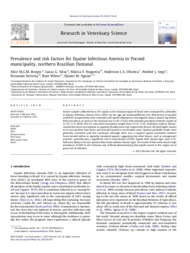Prevalence and risk factors for Equine Infectious Anemia in Poconé municipality, northern Brazilian Pantanal.
Prevalence and risk factors for Equine Infectious Anemia in Poconé municipality, northern Brazilian Pantanal.
Author(s): BORGES, A. M. C. M.; SILVA, L. G.; NOGUEIRA, M. F.; OLIVEIRA, A. C. S.; SEGRI, N. J.; FERREIRA, F.; WITTER, R.; AGUIAR, D. M.
Summary: Serum samples collected from 547 equids in the Pantanal region of Brazil were evaluated for antibodies to Equine Infectious Anemia Virus (EIAV) by the agar gel immunodiffusion test. Risk factors associated with EIAV seropositivity were evaluated and spatial dependence investigated using a Spatial Lag Model. EIAV prevalence on farms in the Pantanal was 52.0% (13/25) with adjusted prevalence between equids of 31.5% (17.4?48.8% 95% CI). Intra-herd prevalence ranged from 5.0 to 77.0%. Statistical analysis demonstrated that farms and animals in regularly flooded areas had respectively 60 and 146 fold higher chance to be sero-positive than farms and animals located in non-flooded areas. Spatial Lag Model results were generally consistent with this conclusion although there was a negative spatial correlation between farms located within in regularly inundated regions, suggesting that other factors, such as management practices, probably play a significant role in transmission of EIAV. Equids with clinical signs were 3.74- fold more likely to be sero-positive than those without clinical signs. The results of this work reveal a high prevalence of EIAV in the Pantanal area of Brazil demonstrating that equids reared in this region are at great risk of infection.
Publication year: 2013
Types of publication: Journal article
Unit: Embrapa Pantanal
Keywords: Brazil, EIAV, Equid, Mato grosso state, Risk factor, seroprevalence
Observation
Some of Embrapa's publications are published as ePub files. To read them, use or download one of the following free software options to your computer or mobile device. Android: Google Play Books; IOS: iBooks; Windows and Linux: Calibre.
Access other publications
Access the Agricultural Research Database (BDPA) to consult Embrapa's full library collection and records.
Visit Embrapa Bookstore to purchase books and other publications sold by Embrapa.

